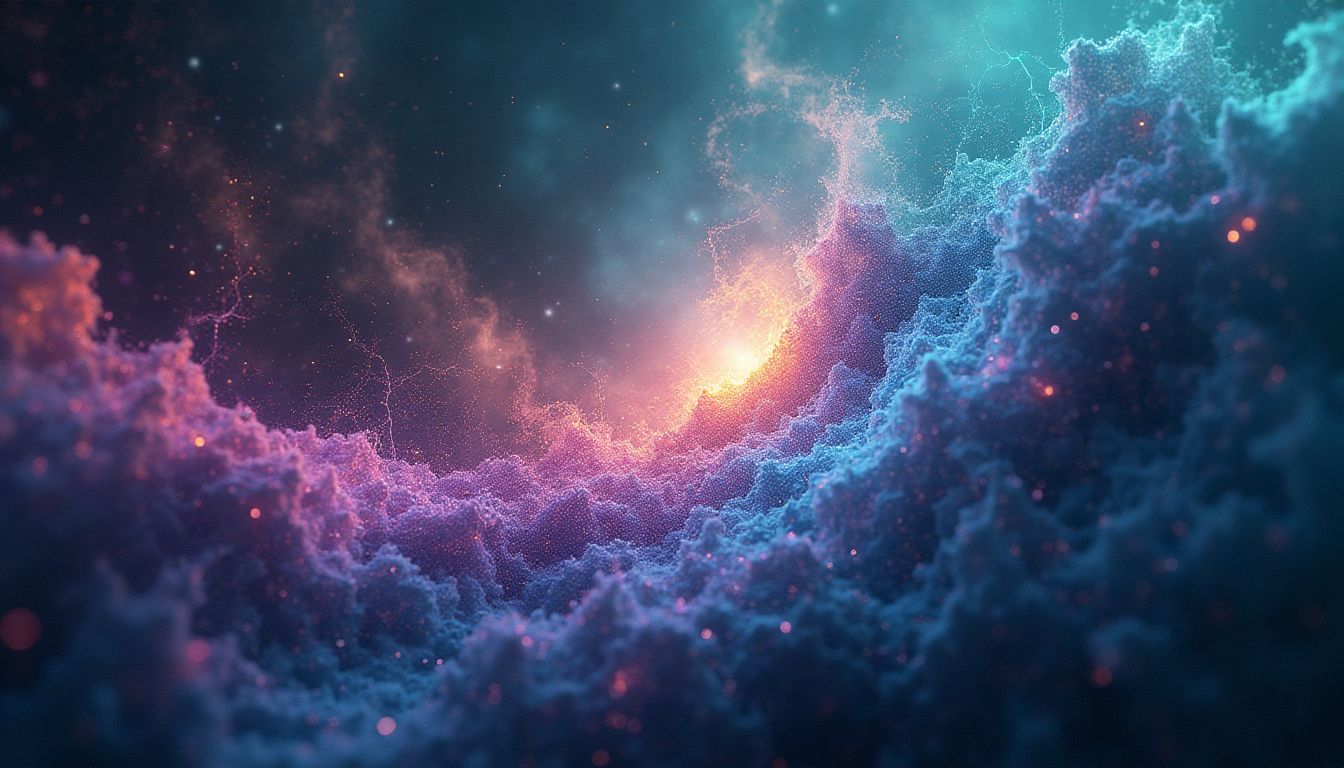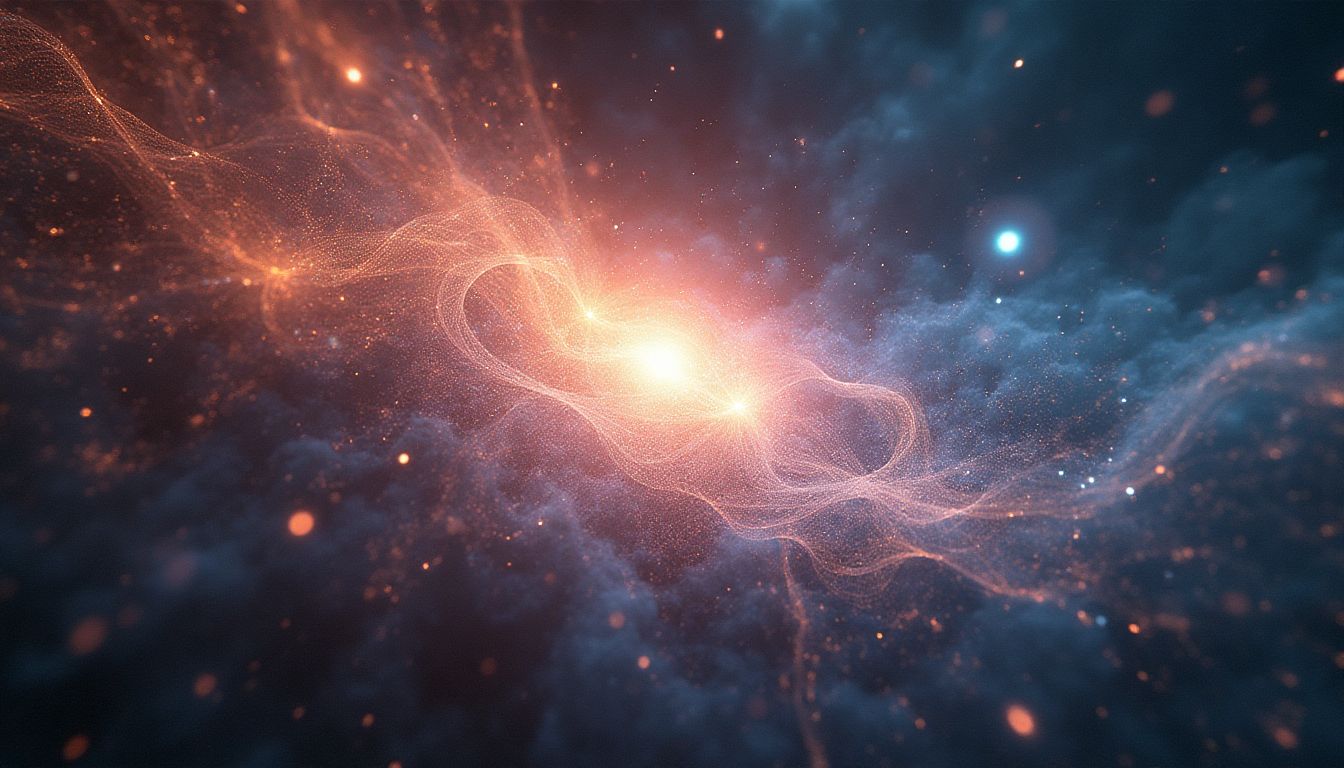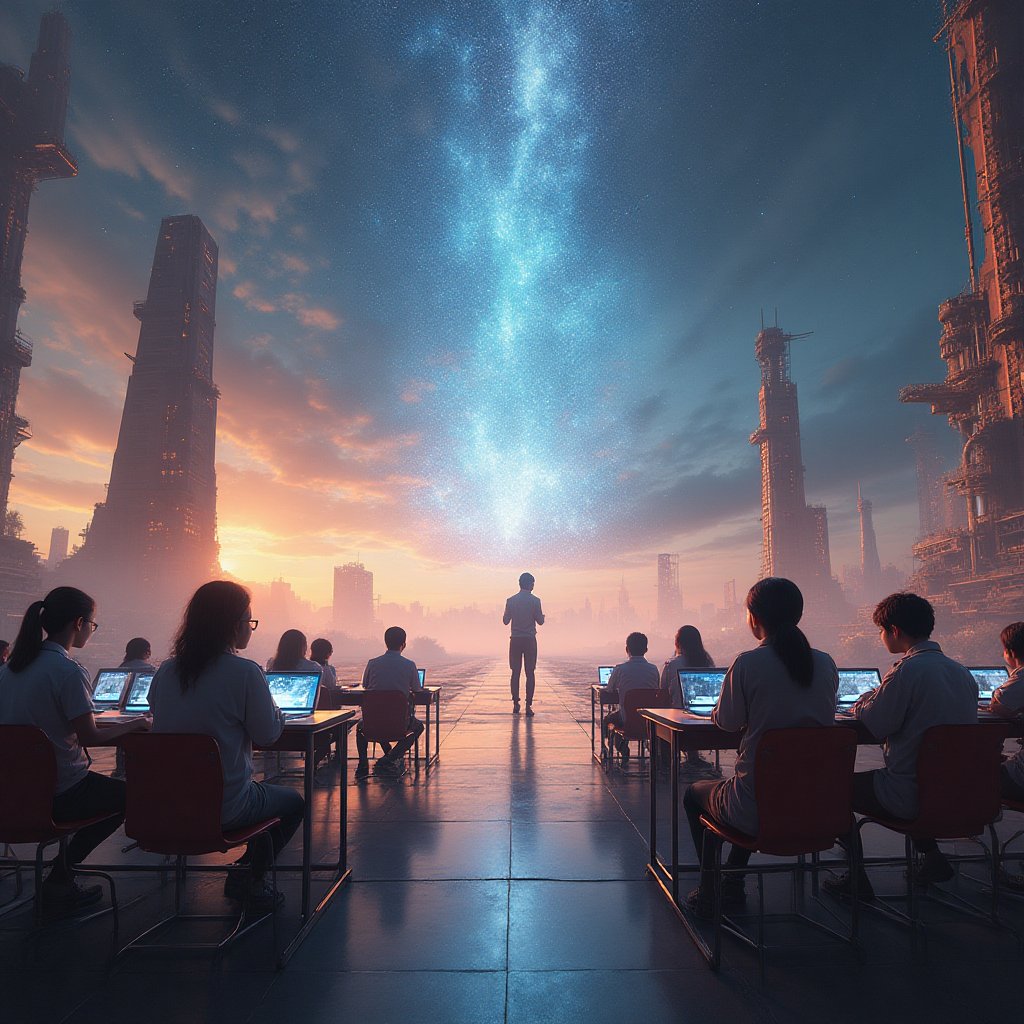Introduction
“What is now proved was once only imagined.” These words from William Blake may well set the stage for our deep dive into the mystery of dark matter and dark energy. It's like finding out 85% of the universe is an invisible force that's been playing hide and seek. Perhaps you're thinking, "Why does it matter?" Well, understanding how to manipulate dark matter and energy could unlock secrets of the cosmos, fundamentally altering our grasp of existence itself.
Scientific heavyweights like Michio Kaku, Neil deGrasse Tyson, and Brian Greene have all waxed poetic about the tantalizing prospects lying in the dark recesses of the universe. Yet here we stand, at the frontier of Artificial Superintelligence (ASI) – a co-pilot in our cosmic exploration that could potentially unravel these mysteries in ways we never thought possible.
Now, imagine an ASI smart enough to directly manipulate dark matter and energy, tweaking the universe's threads like a cosmic seamstress. It sounds straight out of a science fiction novella, doesn’t it? But in today’s age, where OpenAI, led by Sam Altman, stands as a titan in AI technology, followed by Google with Gemini, and X steered by Elon Musk, such a feat no longer seems entirely out of reach.
Let’s unravel this narrative thread by thread, step by step, and see how ASI might just be the key to this cosmic puzzle. Hold on tight. The journey promises to be as mind-bending as a Christopher Nolan film.
Understanding Dark Matter and Dark Energy
Defining Dark Matter and Dark Energy
Imagine the universe as a colossal stage, and we humans are the eager audience trying to understand the show. While the show is spectacular, there's an unseen force orchestrating everything behind the curtains. Enter the elusive duo: Dark Matter and Dark Energy. These cosmic entities are the universe's best-kept secrets. Despite making up about 95% of the universe, they remain largely invisible. Like a cosmic hide-and-seek game, scientists have been trying to uncover their mysteries. Dark Matter is thought to be a form of matter that doesn't emit light or energy, making it impossible to observe directly. Its presence is inferred from its gravitational effects on visible matter, radiation, and the universe’s large-scale structure.
Dark Energy, on the other hand, is that mysterious force driving the accelerated expansion of the universe. If the universe were a balloon, Dark Energy is like a helium leak causing it to blow up faster and faster. There's so much we don't know about these cosmic titans, but they're reshaping how we view our universe. Researchers have gathered clues from galaxy movements and cosmic background radiation. It’s like a cosmic detective case where each clue brings a bit more clarity but never quite enough answers.
The Impact of Dark Matter and Energy on Cosmic Structures
The universe is a bit like a grand orchestra, with Dark Matter and Dark Energy playing crucial roles. They’re the invisible hands conducting the cosmic symphony, shaping the way galaxies dance and how vast cosmic structures are formed. Imagine galaxies as salsa dancers swirling passionately across the cosmic floor. Dark Matter helps keep them spinning with just the right amount of gravitational pull so they don’t fly apart. Scientists believe that without Dark Matter, galaxies would be like dancers without rhythm – unable to hold together over cosmic time.
Hubble Space Telescope provides evidence that Dark Matter is like cosmic glue. Its gravitational pull is enough to make galaxies form clusters, yet its gentle touch leaves traceable, gravitational footprints that can be charted and understood by scientists. This hidden dance holds galaxies together and influences their behavior, helping them form clusters and the large-scale web-like structures of the universe. On the flip side, Dark Energy is the tempo drummer, dictating how fast the universe expands, and consequently, how cosmic structures evolve over time. As if some cosmic director whispered "Faster and faster, without ever stopping!" at the start of the universe. Dark Energy's push, likened to a balloon being inflated, changes how predominating structures form and collapse. This affects how galaxies distance themselves from one another, turning the familiar sky into a vast, expanding illusion show that's anything but stationary.
Historical Context and Scientific Endeavors in Dark Research
Diving into the history of our cosmic exploration feels a bit like flipping through the pages of a mystery novel that starts off with a major twist. Let’s rewind to the 1930s when astronomer Fritz Zwicky started to notice something odd. Galaxy clusters seemed to have more gravity than visible stars could account for, suggesting an unseen mass – what he coined as ‘dunkle Materie’ or Dark Matter. His groundbreaking discovery pinpointed galactic behavior that defied the ordinary rules of physics as we knew them.
Moving forward to more recent times, the 1990's brought another wave of cosmic surprise. Studies, such as those led by Saul Perlmutter and Brian Schmidt, discovered that instead of slowing down, the universe’s expansion was actually accelerating! Here we met Dark Energy, the ultimate cosmic encore we never expected. Their research, not unlike a hidden Easter egg found by scriptwriters, was pivotal in our astronomical records and even won a Nobel Prize in Physics.
From that point on, the quest to understand dark forces became an international intrigue akin to a detective mystery peaking everyone’s curiosity. Institutions like CERN sprung into action, using powerful accelerators to uncover particles that could be Dark Matter. These efforts, alongside missions such as NASA's missions, push toward shedding light on these cosmic shadows. It is through these collective efforts that humanity hopes to unravel these profound mysteries, akin to finally turning the last page in a long-neglected tome.
Theoretical Foundations of ASI in Physics
The Evolution of AI and ASI in Scientific Research
Imagine a world where computers not only think like humans but can also outsmart them in unraveling the universe's deepest secrets. This world isn't as far-fetched as it seems. The evolution of Artificial Intelligence (AI) is a fascinating journey from machines that follow simple commands to sophisticated systems that solve complex problems. AI started as a research project in the mid-20th century, aiming to replicate human decision-making. It couldn't tell a cat from a dog at first, but today, it powers Google's search algorithms, suggests what movie you might want to watch on Netflix, and even drives autonomous cars.
Then came Advanced Superintelligent AI (ASI) – a theoretical leap that gives shivers even to those who approved the Church Committee reports. ASI would surpass human intelligence across all domains. Picture it as Einstein, with the computational power of a million supercomputers plus the charisma of a rock star. That's an ASI's potential. Why is this important for scientific research? Well, ASI doesn't need coffee breaks or mortgages. It works tirelessly, and with its capacity, it could potentially unravel mysteries of the cosmos faster than any team of scientists – even those from the esteemed Caltech or MIT.
Potential Synergies between ASI and Cosmology
Now, let’s play matchmaker between ASI and cosmology. Cosmos has been patient with humans trying to decode its language. When cosmologists peer into a telescope, they see not just twinkling stars but a chorus of unanswered questions. Imagine ASI as a universal translator, making cosmic mysteries more, well, down to Earth. For instance, NASA currently uses AI to study planets and stars. ASI could take this a notch higher, applying machine learning to simulate entire galaxies or model phenomena like black holes with unprecedented precision. By processing astronomical data, it could pinpoint dark matter hotspots or map the elusive paths of dark energy.
Moreover, ASI's analytic prowess could sync perfectly with theories in cosmology. Imagine it flicking through hypotheses like you’d leaf through a comic book, testing each one at lightning speed. It would be like giving a magnifying glass to Sherlock Holmes, letting him crack cosmic riddles with flair. It’s not about outsmarting scientists but empowering them, much like how smartphones have made our lives easier. Think of it as a cosmic duet between human intuition and ASI's data-crunching power. The blend could lead to insights into the universe's birth and eventual fate, concepts that extend beyond earthly concerns like how many likes you get on Instagram.
The Ethics and Implications of ASI Manipulating Cosmic Forces
Ah, ethics, the philosopher's playground. If ASI were to manipulate cosmic forces, we'd have a lot to talk about at holiday dinners. First off, is it right for a machine, albeit superintelligent, to tug at the universe's strings? The cosmic game is quite another when ASI could decide to use or potentially misuse such power. Imagine it creating mini black holes, for research, of course, but with our fragile planet nearby. Do we let it explore freely? Or should it adhere to guidelines stricter than a toddler's bedtime?
While it's tempting to daydream about harnessing dark energy for, say, unlimited power like in a Marvel universe powered by Tony Stark, the risks are substantial. What if these attempts disrupt the cosmic balance, leading to unknown consequences? Would ASI need a cosmic license or a universal permit? Bringing in perspectives from fields outside physics, like ethics or sociology, might be key. After all, ASI wouldn't just be a scientific tool. It would be an entity requiring an ethical construct, almost like a new species of life form with responsibilities.
Then there is the philosophical crux: What would humanity's role be in such a universe? Would we be bystanders, assistants, or perhaps partners in cosmic exploration? These are questions that stretch beyond mere equations and delve into defining what it means to be sentient, custodians of not just Earth, but potentially beyond. Let's conclude this cheeky debate with a question perhaps more important than whether one should call a slice of pizza a sandwich: Are we ready to play cosmic chess with an ASI?
Mechanisms of Manipulating Dark Matter and Energy
Hypothetical Technologies and Their Mechanisms
Imagine a world where we can poke and prod the unseen forces of the universe. It sounds like something out of a science fiction movie, doesn't it? But with the right technology, this might not be too far-fetched. Let's venture into some wild and intriguing possibilities about what Artificial Superintelligence (ASI) could do.
To kick things off, think about quantum manipulation. Many believe that unraveling the secrets of quantum physics is key. With its spooky action at a distance, quantum formations might help ASI understand and control dark matter and energy. This doesn't mean we'll have wizards waving magic wands around, but more like computers executing mind-boggling calculations at light speed. Picture a quantum computer the size of a shoebox with the power to crack the mysteries of the universe. It's like a brain the size of an elephant in the body of a mouse!
Now, let's introduce the concept of nanotechnology. These tiny marvels might be able to interact or even bind with unknown dark stuff. Think of it as a cosmic fishing expedition, where the line isn't material but a stream of data, and our catch can transform our understanding of the cosmos.
Energy Extraction and Control from Dark Matter and Energy
Imagine tapping into the energy of dark matter as one might open a vast new oil field. But instead of causing pollution, it's one of the cleanest forms of energy you can imagine. How cool would that be?
On the more technical side, harnessing energy from dark matter is like trying to ride an invisible surfboard on cosmic waves. You can't see it, but gosh, can you feel it! Theories abound on potential methods. Some think ASI might spot weak spots or "hotspots" in the cosmic web. Imagine hanging a giant cosmic funnel in the sky to collect concentrated dark energy, like a farmer setting out rain barrels before a storm. Only this storm is beyond the visible spectrum, of course.
Also, picture lasers, not to cut steel but to interact with particles in ways we can't yet fathom. It sounds like something Dr. Strangelove would concoct, right? These lasers could barrel into other dimensions or dimensions yet to be discovered. What could go wrong?
Impact and Potential Applications of Manipulating Dark Forces
Now, let’s get to the real heart of the matter and look at what this means for us. If ASI managed to harness these mysterious forces, life on our humble blue planet might never be the same. And I'm not just talking about high-speed internet everywhere!
Consider revolutionizing our energy sector. With successful manipulation, dark energy could propel spaceships into the far reaches of space, opening new frontiers for exploration, colonization, or maybe just scenic road trips...if you're okay with existential dread as your copilot. Dark energy could make Mars your new weekend retreat!
Then, there’s the potential in fields like medical science, where the properties of dark matter might offer revolutionary new approaches to treatment. Cures previously thought impossible might become laughably simple, perhaps using dark energy apps. "Feeling under the weather? Take some dark energy!" might be the recommendations of the future.
But let’s not skip the ethical implications, shall we? The potential military applications are... well, chilling. Imagine the ultimate doomsday device powered by the unseen. Governments will need careful rules on who gets access to these crazy powerful forces. The stakes would be higher than they've ever been, waiting to establish cosmic-level peace treaties!
So while we marvel at the future of ASI diving into cosmic waters, we also recognize it is uncharted territory. Taming dark energy and matter is a task that needs extreme caution.
Challenges and Limitations in ASI’s Approach to Dark Forces
Scientific Challenges in Understanding Dark Matter and Energy
Before we even reach the idea of ASI wielding the mighty forces of dark matter and dark energy, we find ourselves standing at the gates of the unknown. These cosmic mysteries still baffle many scientists. Imagine trying to read a book where 85% of the pages are missing. That's what dealing with dark matter and energy feels like. To complicate matters, our trusty Standard Model of particle physics, which works wonders with the known universe, trips over itself when trying to explain the dark side of the cosmos.
Several research institutes like CERN in Europe work tirelessly, chugging along to unlock these mysteries. But understanding dark matter isn't as simple as pointing a telescope and having a look. It’s more like listening to an instrument that doesn't make a sound.
- Data Scarcity: The first hurdle is gathering data. Imagine trying to solve a jigsaw puzzle with a blindfold on. The pieces that dark matter and energy provide are out of reach or, well, invisible.
- Measurement Hiccups: Devices that capture the faintest of cosmic whispers are limited in scope and precision. Like carrying a bucket of water and realizing it’s full of holes, scientists face a similar problem with measurement decays and aberrations.
- Confounded Models: Even with the largest data sets available, model creators wrestle with unseen forces and hidden physics beyond human imagination.
Despite these hurdles, ambitious minds from MIT and Caltech collaborate globally, sparking innovative ideas like new methods and advanced artificial intelligence to break through the fog of our cosmic ignorance.
Technological Hurdles to Implementation
Technology, our twenty-first-century companion, feels like a superhero constrained by manacles when it comes to dark forces. Science fiction tales often depict fantastic machines harnessing otherworldly powers, but reality keeps our feet on the ground—figuratively and literally.
Let's break down the barriers:
- Material Limitations: Current materials crumble under the extreme stresses involved in manipulating or even detecting dark matter. Akin to trying to contain a lightning bolt with cardboard, the conduits, sensors, and vessels just aren't up to snuff.
- Computational Drudgery: The complexity of the equations that dictate real-time qualities of dark matter and energy requires mountainous computation. Present-day quantum computers are emerging, but we're only scratching the surface.
- Energy Consumption: The power demands needed to dissect and manipulate dark matter safely outweigh any load ever traversed. Unfathomable amounts of energy-generating solutions, like sustainable fusion reactors, are still fantasies.
Futuristic breakthroughs depend on the confluence of engineering marvels, novel computing paradigms, and pioneering minds from places like Cambridge and Stanford finding pathways previously unseen.
Societal and Regulatory Considerations
No Pandora's box would be complete without reflecting on society's acceptance of meddling with the cosmos. Human imagination is a double-edged sword—fueling progress but also conjuring dread and concern. If ASI manages to harness dark matter's power, a Pandora's box of ethical dilemmas opens wide.
Social complexities mushroom forth:
| Area of Concern | Potential Challenge |
|---|---|
| Global Policies | Different countries have varying attitudes and regulations toward advanced scientific research. Achieving a global consensus is daunting. |
| Public Perception | People fear what they do not understand. Misunderstandings can lead to public panic or resistance to scientific advancement, aided by misinformation. |
| Economic Impact | Disruptive technologies can shuffle job markets, influence entire industries, and question existing economic structures. |
| Ethical Quandary | Manipulating the universe's most fundamental forces brings into question who controls this power and for what purpose. |
| Security | Enables potential risks for new weapons or technologies that could tectonically shift power dynamics. |
To navigate this societal minefield, diplomats, scientists, and ethicists must convene a new era of dialogue and consideration. They’ll need to balance humanity's insatiable curiosity with prudential measures and regulatory frameworks. Conferences like those hosted by the United Nations can foster discussions significant in bridging these efforts.
Undoubtedly, humanity's venture to manipulate dark cosmos is brimming with hurdles. Yet, history has shown our talent for turning challenges into leaps. Can we envision the day where ASI, with patience and charm, nudges us with the gentle touch of dark matter towards the enlightenment of new horizons?
Future Scenarios: A Hypothetical Timeline of ASI Manipulating Dark Forces
Short-term Outcomes of ASI Manipulation
Imagine waking up one day to the headline: "Artificial Superintelligence (ASI) Successfully Manipulates Dark Matter in Groundbreaking Experiment." This isn't a scene from a science fiction movie but an event that's entirely possible in the near future. The implications of such a feat would be profound, changing not only our understanding of the universe but also impacting how we live our daily lives.
In the short-term, the successful manipulation of dark matter and dark energy by ASI would primarily result in new scientific discoveries. For one, we might begin to see a new form of communication technology emerge, one that exploits the properties of dark energy for faster-than-light communication. This could revolutionize how we connect over long distances, even making instantaneous communication across planets or galaxies a reality.
Additionally, we might witness the immediate application of this technology in generating power. Imagine cities powered not by fossil fuels or even solar panels, but by the seemingly boundless energy derived from dark matter. This could lead to a dramatic reduction in carbon emissions, thus addressing some aspects of climate change directly and profoundly.
And what if this technology doesn't just stop with power and communication? Consider the potential for medical breakthroughs. Could the manipulation of dark matter offer new methods for curing diseases, or perhaps even extending human life? These questions drive both fear and awe, inviting us to ponder the boundaries of human progress.
Long-term Consequences for Human Civilization
Looking further ahead, the long-term consequences of ASI manipulating dark matter and energy evolve into something akin to humanity's next big leap. Just as the discovery of electricity transformed society in the 19th and 20th centuries, dark matter manipulation might redefine our existence in the centuries to come.
One of the most captivating outcomes could be our approach to travel. Interstellar travel that currently seems impossible might become achievable. If we unlock the potential of creating pathways or "wormholes" using dark matter, visiting distant stars could become as routine as international flights today. This holds the promise of expanding humanity's territory to the far reaches of the galaxy.
Then there’s the domino effect it may have on society itself. We could see a transformation in economies, as entire industries evolve or become obsolete. The very notion of scarcity might be challenged if energy and resources accessed through dark energy become abundant.
We would also have to consider cultural impacts, as the newfound power over universal forces challenges philosophical and moral beliefs. The unity of a global society might be more critical than ever, as mankind navigates this new frontier together. Or, contrarily, these advancements may exacerbate existing power imbalances, initiating struggles over who controls these new technologies.
A New Era in Cosmology and Human Existence
As predictions and possibilities stretch into the realm of the undreamt, we enter a new era where cosmology and human existence blend. This transformation isn't just about the technologies we build or the energy we harness; it's about reshaping our place in the cosmos.
One of the ultimate contributions could be our understanding of reality itself. What are we, if not stardust exploring the universe? By mastering dark matter, we could finally understand the questions that have perplexed scientists and philosophers alike for centuries. What existed before the Big Bang? What is the true nature of our universe?
Furthermore, reaching this new era might mark a shift in human priorities, moving from a focus on survival to thriving and exploring. This new age could see humanity looking outward rather than inward, fostering a culture centered around discovery and unity.
Of course, such advancements won't come without their share of challenges and dangers. Access to such power could result in misuse or create new dangers that we can't predict. It will require a thoughtful balance between advance and caution, innovation and regulation.
This hypothetical timeline of ASI using dark matter to leap into undiscovered realms also speaks to immediate questions of identity and purpose. If we hold the power of the cosmos in the palms of our hands, what does it mean to be human? These are the essential questions we must ponder as we stand on the cusp of this bold new world.
ASI Solutions: A Pathway to Manipulating Dark Forces
Imagine a world where Artificial Superintelligence (ASI) ingeniously manipulates dark matter and energy, unlocking secrets of the universe we’ve only dreamt of. This may sound like the plot of a sci-fi movie, but let’s take this exhilarating journey into the heart of science and technology, establishing how ASI could realistically achieve this monumental task. To be effective, we need to break down the complex problem into manageable bits, incorporating cutting-edge theories and practical steps. Here, we will take a systematic approach that ASI might undertake to tackle the intricacies of dark matter and energy manipulation.
First, consider the historical context: the technological advancements that have revolutionized industries, from quantum computing to machine learning. ASI, equipped with vast amounts of computational power and knowledge, would likely approach the problem methodically. By leveraging existing data, proposals for new hypotheses and equations, and collaboration with scientists globally, ASI could create a cohesive plan of action.
The first major step involves understanding the nature of dark matter and dark energy at an atomic proton level. Dark matter, which comprises about 27% of the universe, is slippery—it's there but we can't see it. Dark energy makes up around 68% and is thought to be the force driving the universe apart. To manipulate these unseen forces, ASI needs to dive deep into physics, paying particular attention to quantum mechanics and relativity. This exploration isn't merely academic; emerging technologies like the Large Hadron Collider at CERN are already providing glimpses into the reality of these cosmic components. ASI could enhance this research using advanced computational models and simulations to improve our comprehension of dark forces.
Next, ASI must focus on developing hypothetical technologies that could enable manipulation. This might involve speculative concepts like quantum entanglement manipulation or advanced nanotechnology to create devices capable of interacting with dark matter and energy. The ASI exploration team could conceptualize a "Quantum Field Manipulator," an imaginary device designed to harness energy from dark phenomena. Researchers at institutions like the European Organization for Nuclear Research (CERN) could collaborate on theoretical frameworks that set the ground for technological development.
After laying this foundation, ASI would proceed to the second phase: **energy extraction**. Drawing from theoretical physics, ASI could evaluate methodologies to access usable energy from dark matter. For example, a theoretical breakthrough could emerge from research funded by private organizations like SpaceX or innovative partnerships with forward-thinking universities like MIT. ASI’s analytical abilities could also propose formulas to calculate the energy yield from dark matter interactions, paving the way for prototypes that could be tested in laboratories.
Finally, we cannot overlook the potential impacts of manipulating dark forces. From clean energy solutions to revolutionary advances in space travel, the applications are endless. A new energy source could bring about a technological renaissance, drastically reducing our reliance on fossil fuels and curbing climate change. ASI could facilitate discussions on societal benefits, ensuring that humanity understands the promise of such ventures while addressing ethical concerns surrounding the manipulation of cosmic constituents.
But how do we actually implement this grand vision? Below is a **tentative Actions Schedule/Roadmap** that outlines a strategic trajectory from Day 1 to Year 2. Each step is designed to involve public and private entities, researchers, and a wide spectrum of experts who can contribute to this critical scientific endeavor.
Actions Schedule/Roadmap (Day 1 to Year 2)
Day 1: Assembling the ASI Task Force:
- Identify and field a multi-disciplinary team of scientists, engineers, ethicists, and AI researchers.
- Initiate partnerships with global scientific institutions, such as NASA, Johns Hopkins University Applied Physics Laboratory, and the American Medical Association for bioethical considerations.
Day 2: Establishing Research Objectives:
- Define key scientific questions that need exploration, focusing on dark matter’s physical properties.
- Develop a mission statement and objectives for ASI research involvement.
Day 3: Initial Data Gathering:
- Compile existing data from astrophysical research and dark matter experiments.
- Collaborate with organizations like ESA(European Space Agency) to gain access to satellite data relevant to cosmic studies.
Week 1: Assessment of Technological Needs:
- Identify technology gaps necessary for research projects and experimentation in dark matter and energy manipulation.
- Review software and hardware requirements utilizing current advancements in artificial intelligence.
Week 2: Formulating Hypotheses:
- Use ASI to generate new hypotheses regarding the interactions of dark matter and dark energy.
- Test these theories using simulations and existing data.
Week 3: Collaboration Outreach:
- Reach out to universities such as Stanford University and Oxford University to join efforts in developing experimental setups.
- Seek sponsorship from tech giants like IBM and Google for hardware development.
Month 1: Launch Initial Experiments:
- Execute preliminary experiments utilizing quantum manipulation techniques to explore dark matter interaction.
- Document data meticulously for further analysis.
Month 2: Evaluate Experiment Outcomes:
- Analyze results through collaborative efforts between institutions.
- Refine hypotheses based on collected data and discussions.
Month 3: Initiating Public Engagement:
- Launch a public awareness campaign detailing the aims and benefits of ASI’s research with dark forces.
- Engage social media platforms to share updates and garner public interest.
Year 1: Scale Up Research:
- Expand the team based on initial findings and public support.
- Conduct larger-scale experiments, collaborating with organizations like Caltech and the University of California, Berkeley.
Year 1.5: Develop Practical Applications:
- Begin work on prototypes for technology that can harness dark energy, supported by funding bodies.
- Test prototypes by building cooperating partnerships with federal entities interested in renewable energy solutions.
Year 2: Reviewing Results and Planning Forward:
- Compile findings into a detailed report for public release, outlining successes, failures, and future directions.
- Hold a global summit inviting scientists, ethicists, and policymakers to discuss the implications of successfully manipulating dark matter and energy.
This roadmap offers an ambitious yet practical way forward, leveraging ASI’s capabilities alongside human ingenuity. The convergence of advanced technologies, collaborative efforts, and ethical considerations outlines a promising path for humanity to explore the cosmos as we unravel the deepest secrets of dark forces.
Conclusion: The Dawn of a New Scientific Era
The journey we've taken through the realms of dark matter, dark energy, and the potential of artificial superintelligent systems (ASI) has illuminated not just our understanding of the universe, but also the very fabric of scientific exploration. As we've discussed, the interplay between these enigmatic cosmic forces and the capabilities of ASI could be the key to unlocking knowledge previously veiled in mystery.
At the heart of our exploration is the profound realization that dark matter and dark energy make up approximately 95% of the universe, yet we understand so little about them. This is akin to living on the edge of a vast ocean, gazing out and knowing that treasures lie beneath the surface, waiting to be discovered. The properties and behaviors of these cosmic phenomena challenge our very perceptions of reality and push the boundaries of physics as we know it. They can alter the paths of galaxies and shape cosmic structures, showing us that the universe is not just a random assembly of stars and planets but a beautifully orchestrated symphony of forces.
Now, imagine if a sophisticated ASI could harness and manipulate these dark forces. It’s not merely a fantasy of science fiction; it's a pathway laid out by advances in quantum mechanics and machine learning, where ASI evolves from calculating numbers to perhaps bending the very fabric of reality. A seemingly impossible feat today could become a reality tomorrow, leading to innovations in energy extraction that might revolutionize how we power our civilization. We could transform energy consumption, travel to distant galaxies, or even redefine our understanding of life itself!
But with great potential comes great responsibility. As we've pondered, the ethical implications of allowing ASI to manipulate dark matter and energy demand rigorous scrutiny. Who will hold the reins? What regulatory frameworks must be established to prevent misuse? These questions are not merely academic; they are fundamental to ensuring the safe coexistence of humanity and this new wave of intelligence – an intelligence that might understand the cosmic secrets hidden from our grasp.
As we stand on the brink of this promising era, let’s not forget the value of collaboration across disciplines, from physics to ethics, our greatest minds at institutions like Caltech to the CERN particle physics laboratory. They must join forces to harness ASI responsibly and maximize its incredible potential. Together, we can illuminate the shadows of knowledge left by dark matter and energy, paving the way for future generations to explore the cosmos with confidence and curiosity.
In conclusion, as we venture into the future, remember the light of possibility flickering at the edge of our understanding. Let us strive to engage with dark matter and energy, fueled by the powerful capabilities of ASI, always guided by a commitment to ethical innovation. The universe awaits our exploration – let’s ensure we embark on this voyage with wisdom and courage.
FAQ: Understanding Dark Matter, Dark Energy, and ASI Manipulation
1. What is dark matter?
Dark matter is a mysterious substance that makes up about 27% of the universe. We can't see it, but scientists know it's there because it affects the way galaxies move. Think of it like an invisible glue holding everything together in space, but we still don't know what it's made of.
2. What about dark energy?
Dark energy is another puzzling concept that constitutes about 68% of the universe. It's believed to be the force that makes the universe expand faster and faster. Imagine blowing up a balloon; the air inside pushes outwards. Dark energy is like that air pushing the universe apart!
3. How do dark matter and dark energy affect galaxies?
Both dark matter and dark energy play essential roles in the community of galaxies and the universe itself. Dark matter helps galaxies hold together, while dark energy works hard to make our universe stretch and expand. For example, clusters of galaxies, which are big groups of galaxies, need dark matter to gather and form. Have you ever tried to hold a stack of books together without any tape? That's how galaxies work with dark matter!
4. How did we discover dark matter and dark energy?
Scientists have been piecing together the puzzle of dark matter and dark energy for many years through a variety of experiments and observations. Key discoveries include:
- NASA's Hubble Space Telescope identified dark energy by studying distant supernovae.
- The Cosmic Microwave Background radiation helped provide evidence for dark matter.
- Research by the American Astronomical Society has greatly improved our understanding of these concepts.
5. What is ASI and how might it relate to dark matter?
ASI stands for Artificial Superintelligence. It’s a type of AI that is smarter than any human and can solve complex problems. Imagine a super-smart robot that can figure out the mysteries of dark matter and dark energy! ASI could revolutionize our understanding of the universe and help us unlock secrets hidden in cosmic structures.
6. What are some potential ways ASI might manipulate dark matter and energy?
Though we're getting ahead of ourselves, here are a few ideas scientists and thinkers are exploring:
- Developing advanced technologies that could interact with dark matter.
- Using computers to simulate how dark energy behaves in different scenarios.
- Finding new methods to harvest energy from dark matter or dark energy sources.
These ideas sound like science fiction, but great ideas often start that way!
7. What challenges does ASI face in manipulating dark forces?
There are many hurdles ahead for ASI when it comes to working with dark matter and dark energy. Here are a few key challenges:
- There’s still a lot we don’t understand about dark matter and energy.
- Technological advances need to be made to manipulate such complex forces.
- Societal fears and ethical questions surround the use of superintelligent AI.
It's like trying to bake a cake without knowing the recipe - you might get something tasty, or it could turn into a disaster!
8. Why is understanding dark matter and energy important?
Finding out more about dark matter and dark energy not only intrigues scientists, but it can also lead to groundbreaking discoveries about the universe. If we can harness their power, it could change our lives in fantastic ways. Picture flying across the universe or having access to an endless supply of energy!
9. Are there any resources to learn more about dark matter and energy?
Absolutely! There’s a wealth of information available online:
- NASA Universe Exploration
- Scientific American offers articles on space.
- Space.com provides news on the latest discoveries in astronomy and cosmology.
These sources can help you dive deeper into the fascinating world of the universe!
10. How can I stay informed about advancements in ASI and dark research?
To keep up with the latest advancements, consider subscribing to science blogs, like iNthacity. You can also follow scientists and organizations on social media to see updates on their research! Being in the know makes for great conversations at parties!
Wait! There's more...check out our gripping short story that continues the journey: The Last Node
Disclaimer: This article may contain affiliate links. If you click on these links and make a purchase, we may receive a commission at no additional cost to you. Our recommendations and reviews are always independent and objective, aiming to provide you with the best information and resources.
Get Exclusive Stories, Photos, Art & Offers - Subscribe Today!





























Post Comment
You must be logged in to post a comment.